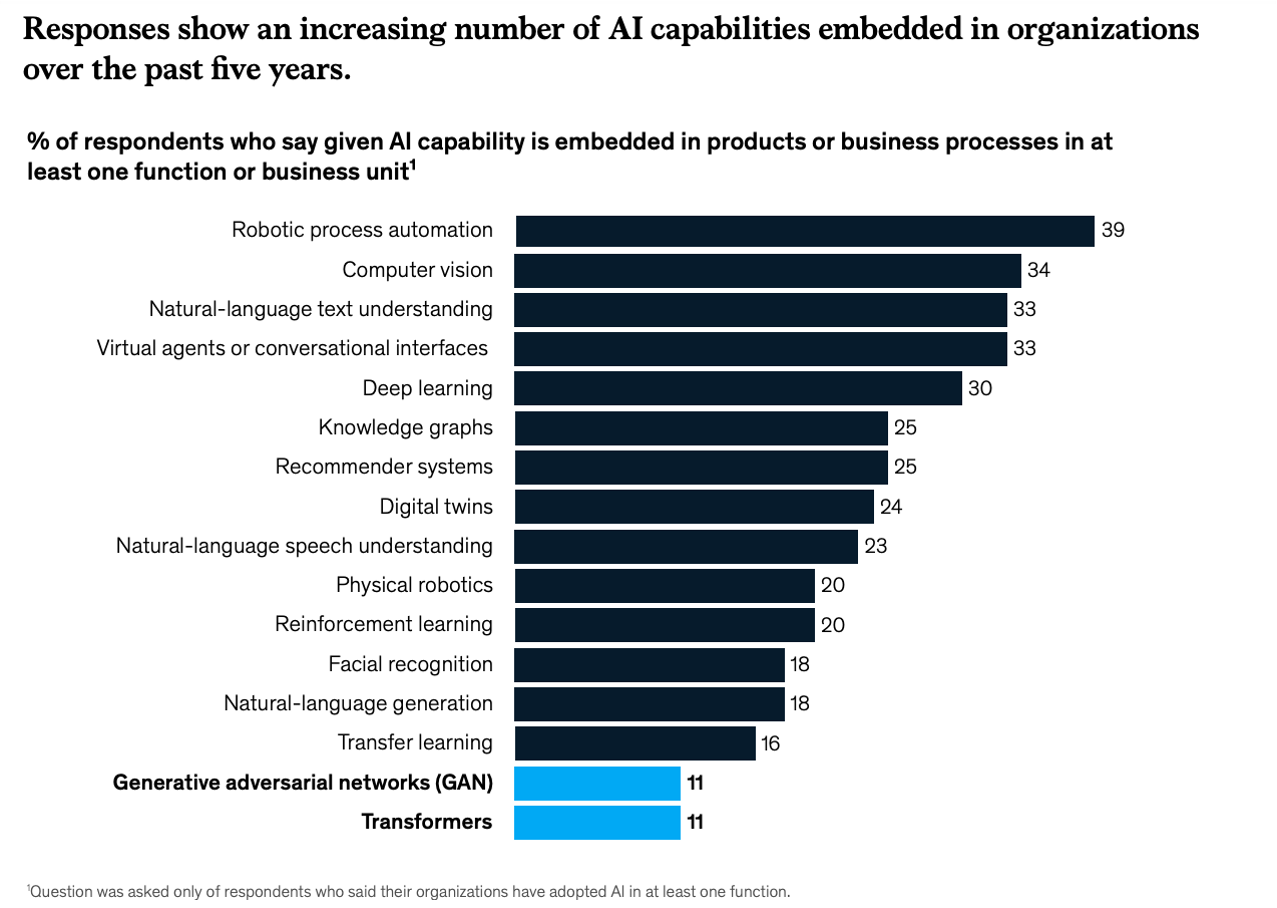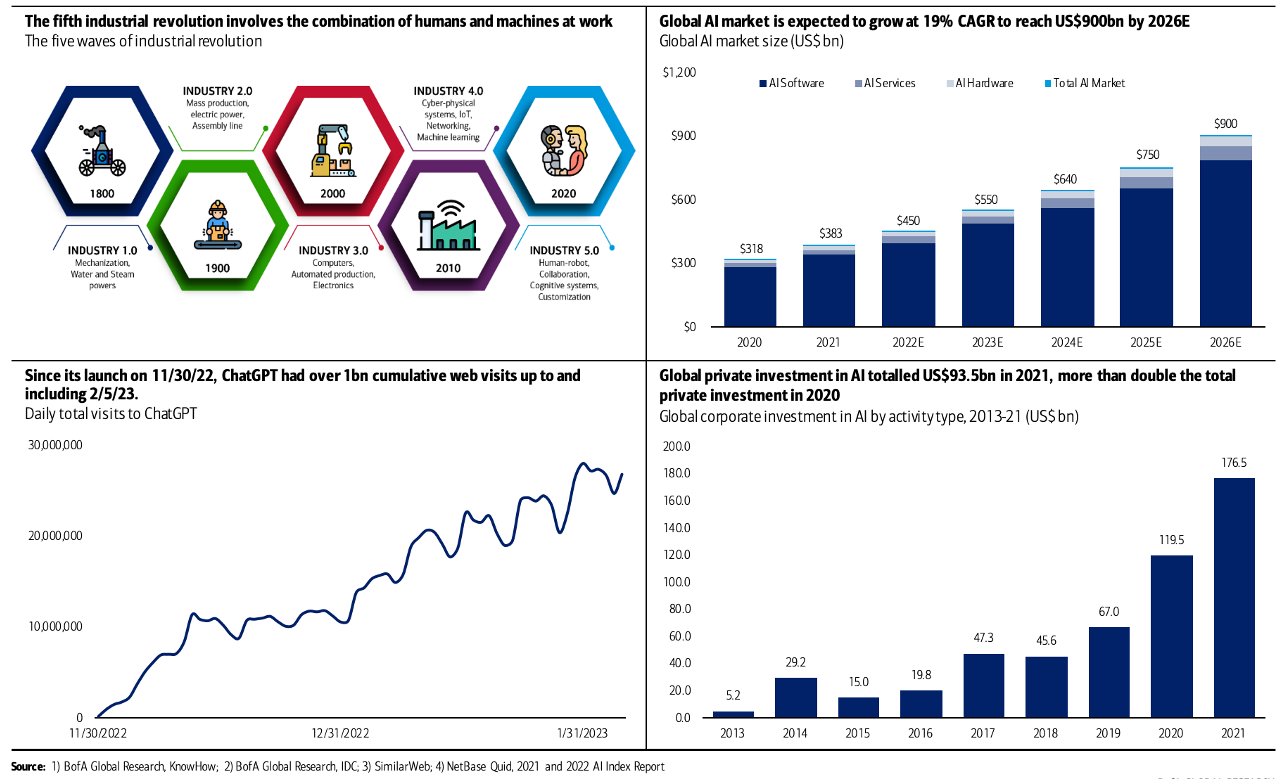Introduction to Artificial Intelligence
“The real question is, when will we draft an artificial intelligence bill of rights? What will that consist of? And who will get to decide that?”
— Gray Scott
Introduction to AI
Artificial Intelligence (AI) is a powerful technology which combines mathematics, computer science, and information engineering to enable machines and systems to perform cognitive tasks such as analyzing data, problem-solving, and decision-making. AI utilizes algorithms that are programmed to learn from data in order to make informed decisions based on what it ‘knows’. This technology is used in everyday applications such as control systems for vehicles, facial recognition for security and personal assistants like Siri or Alexa. AI has the potential to revolutionize how we interact with both people and machines in an increasingly automation-driven world.
The four biggest trends they expect to shape the AI landscape ...
- Multipurpose Chatbots
- combining different modalities—such as image or video recognition—with text
- AI’s First Red Lines
- see what the final version of the EU’s sweeping AI law, the AI Act, will look like
- facial recognition in public places will be restricted for law enforcement in Europe
- regulations could shape how technology companies build, use, and sell AI
- Big tech Could Lose its Grip on Fundamental AI Research
- upstarts working on generative AI are seeing a surge in interest from venture capital funds
- Big Pharma is Never Going to be the Same Again
- it’s possible that initial results from some of these test may come out next year, allowing the first drug developed with the help of AI to hit the market
-------------------------
- Artificial Intelligence (AI):
https://www.ibm.com/cloud/learn/what-is-artificial-intelligence - What’s next for AI: https://www.technologyreview.com/2022/12/23/1065852/whats-next-for-ai/
- AI Business:
https://aibusiness.com/ - EU AI Act:
https://en.wikipedia.org/wiki/Artificial_Intelligence_Act - 141 Myth-Busting Statistics on Artificial Intelligence (AI) [2023]:
https://research.aimultiple.com/ai-stats/ - Artificial Intelligence and the Future of Teaching and Learning (PDF)[May 2023]:
https://www2.ed.gov/documents/ai-report/ai-report.pdf
Table of Contents
- The Brief History of Artificial Intelligence
- Artificial Intelligence: Past, Present, and Future (19:59)
- What is AI? (4:51)
- Why now? (0:54)
- Real Applications (4:03)
- How to Find Use Cases? (1:43)
- Human Creativity in AI (1:51)
- How Do GANs work? (1:27)
- Why Trust AI? (1:49)
- Explainability and Trust (1:27)
- Professor Analogy (5:21)
- Artificial Intelligence vs. Augmented Intelligence (5:48)
- Humans vs. AI: Who makes the best decisions? (8:57)
- What are GANs? (8:23)
- Interview: Future of AI (7:16)
- The Rise of Artificial Intelligence (11:18)
- The AI revolution: Google's developers on the future of artificial intelligence | 60 Minutes (27:20)
- References
Language Recognition, Image Recognition, and Image Generation Capabilities
It's easy to take for granted how computers have become such a vital part of our existence, given the rapid speed at which they've advanced. In particular, AI systems' language and image recognition abilities have seen a huge development in recent years. Ten years ago, no computer had yet achieved the proficiency of humans regarding these capabilities; however, machine learning has continued to progress extensively since then - so much so that now machines are surpassing people in certain domains. Artificial Intelligence systems have become very proficient in producing images. Over the last few years, their expertise has been incredible as AI went beyond generating faces to also creating pictures based on verbal instructions. AI's ability is now such that any prompt can be transformed into a realistic picture with exquisite detail and accuracy.
Not only is AI able to produce stunning images, but its capability for parsing and responding to human language has seen incredibly rapid evolution in recent years. Everywhere we look, AI is augmenting linguistic expression: emails get auto-completed; online languages receive swift translation; videos become transcribed with little effort; students use AI models as part of their homework assignments; reports come together automatically, and media outlets employ the power of artificial intelligence-generated journalism. While these impressive systems have yet been able to generate long passages that make sense on a narrative level, progress continues at an exponential rate.

What Is Next?
The AI systems that we just considered are the result of decades of steady advances in AI technology. Training computation is one of three essential elements that dictate the power and potential of AI systems. The other two are algorithms and input data. In the last six decades, training computation doubled every 20 months; however, since 2010 this exponential growth has accelerated to a remarkable rate with doubling happening in just 6 short months! This surge in training computation has enabled us to unlock more impressive capabilities from our AI solutions. Further, AI scientists are exploring the potential of long-term trends to forecast what could be achieved in the future. An AI researcher conducted an exploration that questioned when computation would match human brain activity. The study proposed that there is a 50% probability that groundbreaking AI will take effect by 2040 — only twenty years away!
Computers and AI have drastically reshaped our world, but we are just scratching the surface. Technologies that now seem mundane were once revolutionary breakthroughs. What's more, advancements in this field continue to grow exponentially - investments in artificial intelligence technology and computation training times decrease by an astonishing rate within only six months! This trend shows no sign of abating whatsoever anytime soon.

We are entering the fifth industrial revolution with Artificial Intelligence (AI). More data is created per hour today than in an entire year just two decades ago and global data is expected to double every two years. The data we are creating is increasing exponentially and we need AI to analyze and interpret it.
https://business.bofa.com/en-us/content/ai-trends-impact-report.html
Dr. Craig Kaplan discusses Artificial Intelligence -- the past, present, and future. He explains how the history of AI, in particular the evolution of machine learning, holds the key to understanding the future of AI. Dr. Kaplan believes we are on an inexorable path towards Artificial General Intelligence (AGI) with "god-like" powers. He explains the likely paths that will lead to AGI and what all of us can do now to become better prepared for what is coming.
What is AI?
Why now?
Real Applications
- AI / ML / Deep Learning
- AI tasks
- Succeeding at complicated tasks that cannot write instructions by hand
- Automating the ineffable
- More sophisticated algorithms
- More abundant data
- More computer power
- Image classification
- Communication (capture meaning)
- Smart reply
- Playing games
- Self-driving cars
- Cooling data centers (energy efficiency)
- Island analogy
(what it means to do your task correctly)
- Humans at both ends of the process
(do not hand over the entire task to machines)
- Two apps
- Machine 1: real or fake
- Machine 2: trick the first one
Why Trust AI?
Artificial Intelligence is ushering in a new era of advanced computational capabilities to assist humans in many facets of our lives from personal devices to workplace operations. Artificial Intelligence can diagnose diseases faster, drive cars more safely and effectively, create smarter shopping experiences, and offer more personalized services that are tailored to individual preferences.
Yet despite its widespread use, questions of trust are understandably raised. While it is true that AI systems may contain flaws and vulnerabilities that can threaten data security, recent advancements in Artificial Intelligence have allowed for much greater accuracy in the assessment and development of trust in AI.
The trust in Artificial Intelligence must not be based solely on the fact that technology has been growing exponentially but instead on its track record of providing consistent and reliable results whatever the circumstances. This has been achieved by introducing a variety of different safeguards and cross-checking mechanisms into Artificial Intelligence models.
So, Artificial Intelligence is a familiar term, but what is Augmented Intelligence?
Martin Keen explains the differences between Artificial, Augmented, and human intelligence, the value of each, and how they all can work together.
Recent developments in artificial intelligence (AI) are providing decision-makers with an ever-growing array of options. AI can be used to accurately identify many patterns. Augmented intelligence, which combines both human and machine decision-making forces decision-makers to account for human cognitive bias. In addition, when it comes to decision-making, there is the question of whether it should be done through a 'forced display' or an 'optional display'. Automation bias is more likely when decisions are done by forced displays that ignore human judgment, as opposed to optional displays which allow for subjective decision-making by the user. Finally one should also consider the issue of trust or accuracy percentage when using AI for decision-making as well as its potential to make decisions based on a fair and accurate presentation of information rather than subjective decisions from a human source.
Generative Adversarial Networks (GANs) are a type of machine learning algorithm used for generating new data. They are composed of two distinct models, a generator and a discriminator. The generator takes in random noise as input and attempts to create realistic data such as images or speech, which is then fed into the discriminator. The discriminator is trained to recognize real data from the generated data, such as distinguishing a real picture of a dog from a fake one.
The two neural networks are in constant competition with each other, forcing both models to improve over time until the generator can create images indistinguishable from real-world ones.
For example, you can take a picture of a beach and use GANs to apply the style of a painting to it. GANs are also used for creating real-looking data in fields such as medical imaging or natural language processing.
Interview: Future of AI
- How will AI affect our future?
- AI 2041: Explores the Impact of AI
- Pros / Cons
- Seven AI Developments
- Human lifespan will grow by as much as 20 years
- Ubiquitous household robots
- Virtual meetings vs real meetings via VR/AR
- AI will learn to serve human needs
- AI will usher in a new economic model
- Smart cities and autonomous vehicles
- AI teachers will help educate
- Misconceptions
- AI is human-like
"AI will be the defining development of the 21st century. Within two decades, aspects of daily human life will be unrecognizable. AI will generate unprecedented wealth, revolutionize medicine and education through human-machine symbiosis, and create brand new forms of communication and entertainment. In liberating us from routine work, however, AI will also challenge the organizing principles of our economic and social order. Meanwhile, AI will bring new risks in the form of autonomous weapons and smart technology that inherits human bias. AI is at a tipping point, and people need to wake up – both to AI’s radiant pathways and its existential perils for life as we know it."
AI 2041: Ten Visions for Our Future: https://www.ai2041.com/
Six experts in the fields of robotics, sci-fi, and philosophy discuss breakthroughs in the development of AI that are both good, as well as a bit worrisome.
- The Origins of Artificial Intelligence
- presented by Patrick Grim
- What are Neural Networks
- presented by Michael L. Litman
- ELIZA and the Turing Test
- presented by Steven Gimbel
- Can We Make True Artificial Intelligence?
- presented by Charles L. Adler
- Isaac Asimov’s Three Laws
- presented by Gary K. Wolfe
- Does “Truce” Translate to Binary?
- presented by Indre Viskontas
The Rise of Artificial Intelligence:
https://www.youtube.com/watch?v=2MdMLahvLXo
We explored what's coming next at Google. CEO Sundar Pichai told us AI will be as good or as evil as human nature allows. The revolution is coming faster than you know.
The AI revolution: Google's developers on the future of artificial intelligence | 60 Minutes:
https://www.youtube.com/watch?v=880TBXMuzmk
- Introduction to AI / ML (1:27:40)
https://www.youtube.com/watch?v=lYWt-aCnE2U - 12 steps of machine learning - Steps 0-5 (1:23:24)
https://www.youtube.com/watch?v=lIFLeHDanmA - 12 steps of machine learning - Steps 6-12 (2:00:46)
https://www.youtube.com/watch?v=fwK5xKUwQbw - AI algorithms (1:31:01)
https://www.youtube.com/watch?v=9PBqqx38WeI - Full Course (6:22:29)
https://youtu.be/1vkb7BCMQd0


